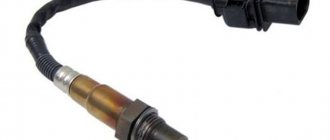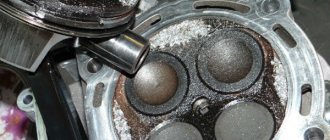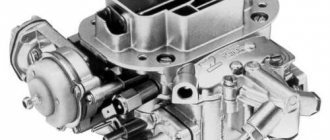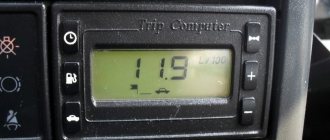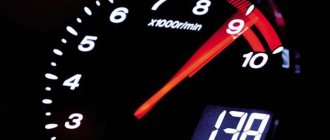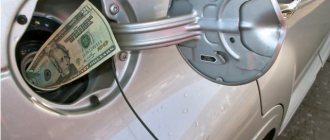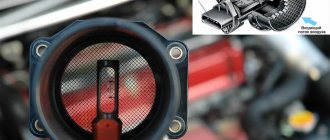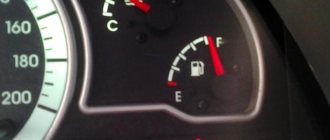After they released a car with distributed injection, car enthusiasts are interested in what the fuel consumption of the VAZ 2107 (injector) is. The reason for this curiosity lies in the higher fuel consumption than the manufacturers indicate.
The VAZ car is familiar to every Russian. Since 1982, the VAZ 2105 was replaced by a new model - the “seven”, that is, the VAZ 2107. This was visible in the changes that the car underwent.
| Model | Consumption (highway) | Consumption (city) | Consumption (mixed cycle) |
| VAZ 2107 - injector | 7 l/100 km | 11.5 l/100 km | 8.5 l/100 km |
They hid in changing the appearance of the hood, adding some details inside the car, and an aggressive radiator grille appeared. City of production – Nizhny Novgorod, Russian Federation.
The fuel consumption of a VAZ 2107 per 100 km with injectors of the AI-92 and AI-95 brands is presented as follows:
- on the highway - 6.7-8.5 liters;
- in urban conditions - consumption increases to 11.5 liters.
Plus, the factors of gasoline quality and the driving style of the car enthusiast are added to everything. Therefore, some have more consumption, others have less.
How does this system work?
In order to correctly determine in the future why you are using a lot of fuel, you need to know how the engine power system works. With this knowledge, you will already know how to reduce the fuel consumption of your UAZ.
After air enters the intake manifold, the volume will be measured by a certain sensor. All this information will then go to the ECU. The process will receive the task of injecting fuel through an injector, or, to be precise, through injectors. Everything that is released into the atmosphere is detected by the exhaust measurement sensor. The data obtained helps determine the actual fuel consumption.
Already with knowledge about the operation of the entire system, it is easier to find the exact reason for the unreasonably high consumption of gasoline.
Main ways to reduce consumption and consequences Consumption according to reviews
| Consumption of VAZ 2107 injector in the city; AutoTop air dampers Solex and Ozone are covered air dampers of carburetors 2108, 21081, 21083 Solex and 2105, 2107 Ozone are not fully open due to their incorrectly adjusted drive. Sometimes some car owners, having a worn-out engine in their car, try to resurrect its former throttle response, intentionally setting some closing the carburetor air damper, thus forcibly enriching the fuel mixture and slightly resuscitating the engine's former capabilities. Overestimated fuel consumption is influenced even by the condition of the brake software, which allows accounting, if one of the working cylinders is faulty, the car will begin to slow down, and the resistance to movement will then increase. |
- driving style - during fast dynamic driving, gasoline literally “flies down the drain”;
- season - in winter a lot of fuel is spent on warming up the internal combustion engine;
- the serviceability of the power unit - if the engine is running rough, the fuel does not burn completely, consumption increases;
- tire pressure - with poorly inflated wheels, the resistance to movement increases, and accordingly, the RT increases;
- settings, serviceability of the carburetor itself.
Reasons for overspending
To determine the causes, technicians use a special device - a tester. They check the electronic control unit and sensors. There are several main reasons when fuel consumption may increase:
- Aggressive driving.
- Precipitation on the walls of nozzles, measurement of their flow area.
- Incorrect operation of the sensors.
- The glow number of the spark plugs does not correspond to that stated by the manufacturer.
- The car's air engine is clogged.
How to reduce fuel consumption on a VAZ 2107
RT on VAZ cars with a carburetor engine depends on many factors:
- driving style - during fast dynamic driving, gasoline literally “flies down the drain”;
- season - in winter a lot of fuel is spent on warming up the internal combustion engine;
- the serviceability of the power unit - if the engine is running rough, the fuel does not burn completely, consumption increases;
- tire pressure - with poorly inflated wheels, the resistance to movement increases, and accordingly, the RT increases;
- settings, serviceability of the carburetor itself.
To save money on refueling a car, motorists are advised to install gas-cylinder equipment - gas is consumed no less, but the fuel itself costs at least almost half as much, refueling with methane is especially cheap.
It should be noted that converting a car to gas is beneficial only if the car is used regularly and covers at least 30-40 thousand kilometers per year. The thing is that before you can profit from saving on fuel, you first need to recoup the cost of installing the equipment and the gas equipment itself.
We diagnose ourselves
You can find out for yourself how much fuel is actually consumed.
To do this, you need to fill a full tank of gasoline, which is 39 liters, and drive until the gas level indicator is in the middle. This will take more than one hour of moderate driving. Then we go back to the gas station.
We calculate: divide the volume of fuel poured by the mileage on the odometer. This way you will find out the average gasoline consumption of a VAZ 2107 per 100 km. If fuel consumption standards are exceeded, you yourself will not be able to diagnose the exact cause of the problem. Then it is recommended to go to a service station.
Video: the owner of a VAZ-21074 injector shares his impressions of the car
Increased fuel consumption is even affected by the condition of the braking system; if one of the working cylinders is faulty, the car will begin to slow down, and the driving resistance will increase in this case. per minute 3750 Number of cylinders 4 Cylinder arrangement in-line Acceleration time to 100 km h, seconds 15 Maximum speed, km h 150 Fuel consumption city highway mixed mode, l 100 km 9.7 7.3 8.5 Gearbox 5-speed manual transmission Independent front suspension multi-link Suspension rear dependent Front disc brakes Rear drum brakes Tire size 175 65 R13 Wheel size 5Jx13 Body type sedan Length, m 4.145 Width, m 1.62 Height, m 1.446 Wheelbase, m 2.424 Ground clearance, cm 17 Front track, m 1.3 65 Rear track, m 1.321 Curb weight, t 1.06 Gross weight, t 1.46 Number of doors 4 Number of seats 5 Rear-wheel drive.
Statistics
The fuel consumption of a Lada 2107 with an injection engine is perfectly shown by statistics provided by the manufacturer and figures received from car enthusiasts.
The manufacturer claims that when driving on the highway, the car will normally consume 9 liters of gasoline, but in reality we see that consumption does not exceed 7.75 liters.
Driving in urban conditions should consume only 9.70 liters, but here the figure exceeds 10.25 liters. With a mixed type of driving, the readings from the manufacturer and the car enthusiast practically coincided, the former had a consumption of 8.50 liters, and the latter - from 8.82 liters. However, we see that in practice the consumption is higher.
The passport does not indicate how much gasoline is consumed when driving off-road. Having checked it ourselves, we see that such driving requires more than 9 liters of fuel.
VAZ 2107: fuel consumption per 100 km
If we take into account that the injector is more capricious and finicky in terms of fuel quality and settings requirements, then the advantage in fuel consumption is completely leveled out. Justification remember the simple formula: in 1st gear, start from a standstill, for acceleration there is 2nd gear, for afterburner and overtaking there is 3rd, in 4th gear you move around the city, and in 5th gear you can switch to the highway.
Engine versions
Model VAZ 2103
The first engine that was installed on the “seven” was 2103, 75 hp, 1.5 liters. The results showed that in this carburetor car the speed does not exceed 155 km per hour. At the same time, fuel consumption within the city is 11.5 liters.
Model VAZ 2104
New engine – 2104, 72 hp, 1.5 l – injection. The manufacturer claims that a car with this engine can reach a maximum speed of 150 km per hour. But the fuel consumption of the VAZ 2107 decreased to 8.5 liters. \
VAZ 2107 injector details about fuel consumption
To save money when refueling a car, motorists recommend installing gas-cylinder equipment; gas is consumed in this case, but the fuel itself costs almost half as much, especially methane refueling is inexpensive. The engine from the VAZ-2106 was installed on the VAZ-21074 without changes; among other things, the camshaft chain drive was left, which, compared to the belt drive used in the VAZ-2105, is more durable and reliable, although noisier.
Questionable fuel saving methods
Sometimes motorists give advice on how you can save on RT, but not all the proposed methods work, and often savings in such ways turn out to be dubious.
- Reducing the number of idle speeds. It should be noted that idling is far from the most economical mode, and if you measure the CO level with a gas analyzer, then at idle the device will show the emission of harmful impurities in the exhaust gases no less than at medium speeds. In addition, when the idle speed is reduced from 800-900 rpm to 500-600, there is a possibility that the engine will constantly stall when the gas is released.
- Magnetic activators. On the Internet you can still find advertisements for “miracle” remedies that supposedly reduce fuel consumption when used. The “magic” device only needs to be attached to the fuel line, and the RT will immediately decrease by 20-30%. At the same time, sellers advise not to accelerate sharply or drive at high speeds. In a word, all these activators are pure deception, luring money out of customers’ pockets.
- The car is coasting. You can get advice from car enthusiasts - when descending from a mountain, engage neutral gear, and in this case the load is reduced, and a lower RT is obtained. It is worth noting that this driving style is unsafe - if the engine stalls, the vacuum brake booster will stop working, braking efficiency will noticeably decrease, which can lead to an emergency.
- To save money, you need to fill with cheaper gasoline. Such savings are very doubtful. Firstly, the car drives worse on gasoline fuel with a low octane number, and the engine itself may suffer from the quality of the fuel. Secondly, with bad gasoline the fuel consumption becomes higher than with good gasoline, and the difference in the price of fuel in this case is reduced to zero.
- Adding additives to gasoline. You need to know that manufacturers already add all the necessary fuel additives to the fuel, and all unnecessary additives can only harm the car engine. Experiments with additives can lead to major engine overhauls.
Salon
Inside, the car looks the same as the “four” and “seven”. The driver has a four-spoke steering wheel without any adjustment and a flat fabric seat. The instrument panel on the VAZ-21053 is a pointer panel with modest backlighting. Nevertheless, everything necessary was located here: speedometer, tachometer, fuel level and antifreeze temperature sensor.
By the way, the “five” became the first car among the “Classics”, which was standardly equipped with a heated rear window. In addition, the front door windows have been ventilated in the cabin. However, in order to place deflectors in the panel, it was necessary to reduce the already small-sized glove compartment. The interior here is so simple that the only electronic items are interior lighting and rear window heating. All window regulators are mechanical. The seats are manually adjustable. Among the shortcomings in the interior, the owners note:
- Poor sound insulation. It is very noisy inside, especially at speed, when the roar of the engine can be heard from under the hood.
- Uncomfortable seats. Although they received height-adjustable headrests, they were extremely uncomfortable. There was no lumbar and lateral support. In addition, the seats quickly sank and rubbed. Because of this, you could often see covers on the seats of Zhiguli cars.
- Bad ergonomics. In particular, this concerned the steering wheel and inconvenient controls on the stove.
Chassis
The basic basis for the VAZ-21053 model was the 2101 platform. There were no design changes, except for rearranging the brackets when releasing export modifications with right-hand drive.
The front suspension of the VAZ-21053 is two independent units (left and right), consisting of profiled stamped arms that are attached to the transverse beam using silent blocks. The ends of the levers are connected to the steering axle by means of ball joints. Each pair of levers rests on a steel spiral spring, which, with its upper ring, fits into a special socket mounted in the sides of the engine compartment. A hydraulic shock absorber is installed in the middle of the spiral. Both lever units are connected to each other by a rod, which dampens vibrations and ensures lateral stability of the car.
The rear suspension of the pendulum design consists of trailing arms connecting the underbody to the axle beam. Spring coils along with shock absorbers are also an integral part. The lateral stability of the car is ensured by a special stabilizer beam located behind the rear axle.
